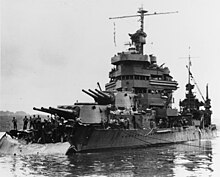Battle of Tassafaronga
| date | November 30, 1942 |
|---|---|
| place | off Tassafaronga , Guadalcanal , Pacific |
| output | Japanese victory |
| Parties to the conflict | |
|---|---|
| Commander | |
| Troop strength | |
| 4 heavy cruisers, 1 light cruiser, 4 + 2 destroyers |
8 destroyers |
| losses | |
|
1 heavy cruiser sunk, |
1 destroyer |
The Battle of Tassafaronga was a naval battle between the American and Japanese fleets in World War II during the Pacific War on November 30, 1942 . It was the last in a series of months in the Battle of Guadalcanal . The battle was fought in the strait between Guadalcanal and Savo Island and was named after the Japanese base Tassafaronga on Guadalcanal, the target of the Japanese destroyers.
prehistory
After the sea battle of Guadalcanal , the Japanese commanders had doubts as to whether the island could be retaken. So they turned to New Georgia , northwest of Guadalcanal, to set up another base.
The bombardment of Guadalcanal was stopped, but the Tokyo Express continued to deliver supplies and to carry out evacuations. One of these trips led to the last great battle of this campaign.
On November 30, 1942, Rear Admiral Tanaka Raizō led eight destroyers . Six of them served as transporters ( Kuroshio , Oyashio , Kagerō , Suzukaze , Kawakaze and Makinami ) and were loaded with supplies. Only Tanaka's flagship Naganami and the Takanami were fully ready to fight.
The Task Force 67 , a recently-formed cruiser / destroyer force, consisting of the heavy cruisers USS New Orleans , USS Minneapolis , USS Pensacola and USS Northampton , the light cruiser USS Honolulu and the four destroyers USS Fletcher , USS Drayton , USS Maury , and USS Perkins under the command of Rear Admiral Carleton H. Wright cruised north of Espirito Santo . The destroyers USS Lamson and USS Lardner came from a mission as escort to Guadalcanal, where they were ordered to join Task Force 67. Since the commanders could not be briefed due to lack of time, they were assigned a position behind the cruisers.
The battle
The Minneapolis had radar contact with the Japanese ships shortly after 11 p.m. , whereupon three American destroyers shot down twenty torpedoes while the American cruisers opened fire. The Takanami was hit by shells and sank, but the American torpedoes missed their target. The muzzle flash illuminated the American ships, which allowed the Japanese to see clear targets and shot down twenty torpedoes. After that, they turned to escape in the dark.
The American ships failed to maneuver to avoid the torpedoes. The Minneapolis was hit by two torpedoes, one of which hit the forecastle in front of the barbette of tower A, causing it to buckle downwards. The other torpedo hit a boiler room, which after a short time was under water. The New Orleans was hit by a torpedo, which also damaged the forecastle. The Pensacola was also hit and damaged, the Northampton received two hits, which later sank. The damaged heavy cruisers were directed to Tulagi , where emergency repairs were carried out, but they were inoperable for more than nine months.
aftermath
This battle underscored America's inferiority in night fighting and led to much discussion in the Pacific Fleet about tactical principles.
literature
- Morison, History of United States Naval Operations in World War II

